Fraud Risk Factors in Financial Statements
VerifiedAdded on 2020/03/04
|10
|2449
|39
AI Summary
This assignment delves into the identification of potential fraud risk factors within a company's financial statements. It examines instances where manipulated asset valuations, such as plant and equipment, may indicate fraudulent activity. The analysis also considers internal control weaknesses, including the sudden implementation of a new IT system and changes in depreciation policies, as red flags for potential fraud.
Contribute Materials
Your contribution can guide someone’s learning journey. Share your
documents today.
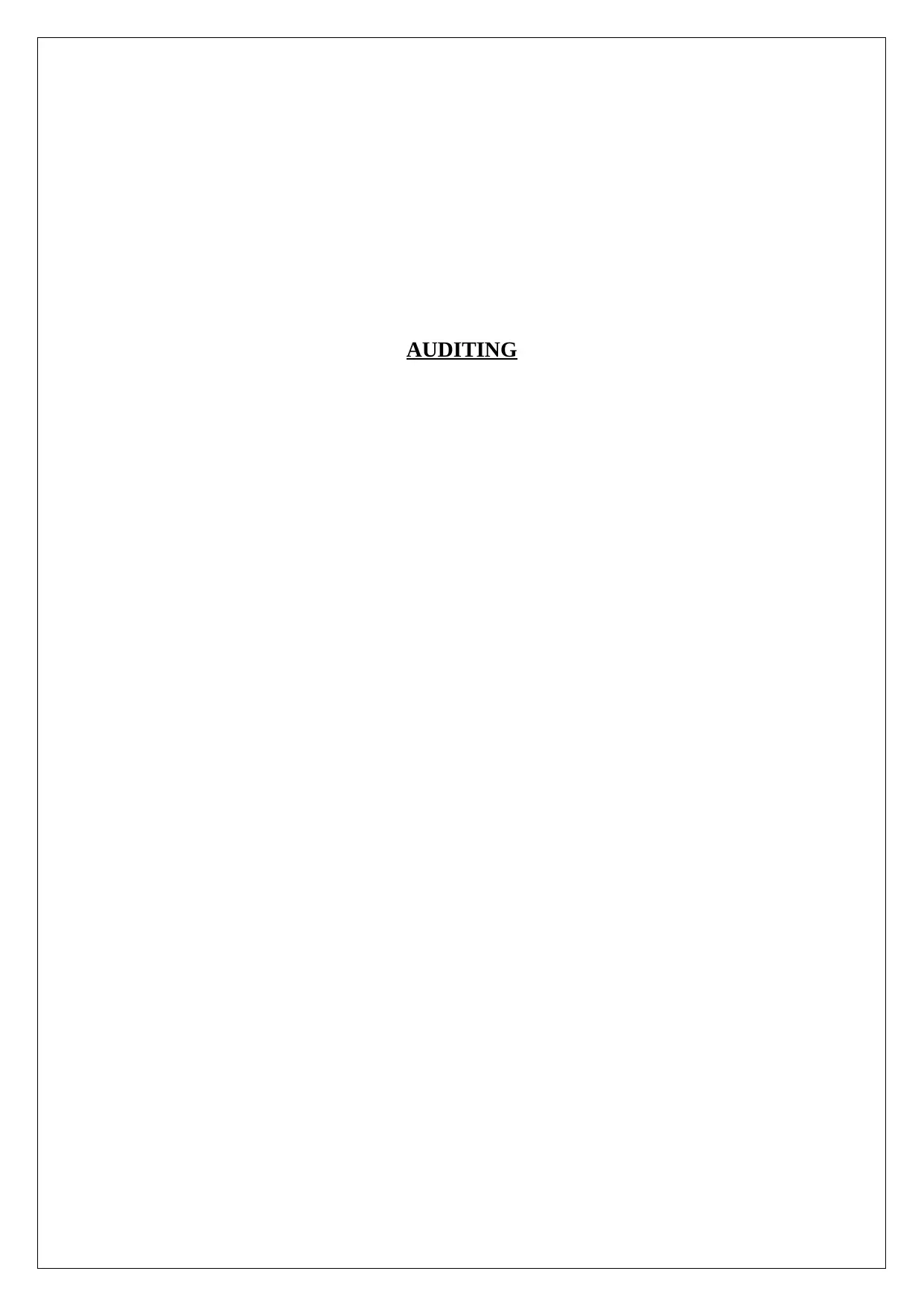
AUDITING
Secure Best Marks with AI Grader
Need help grading? Try our AI Grader for instant feedback on your assignments.
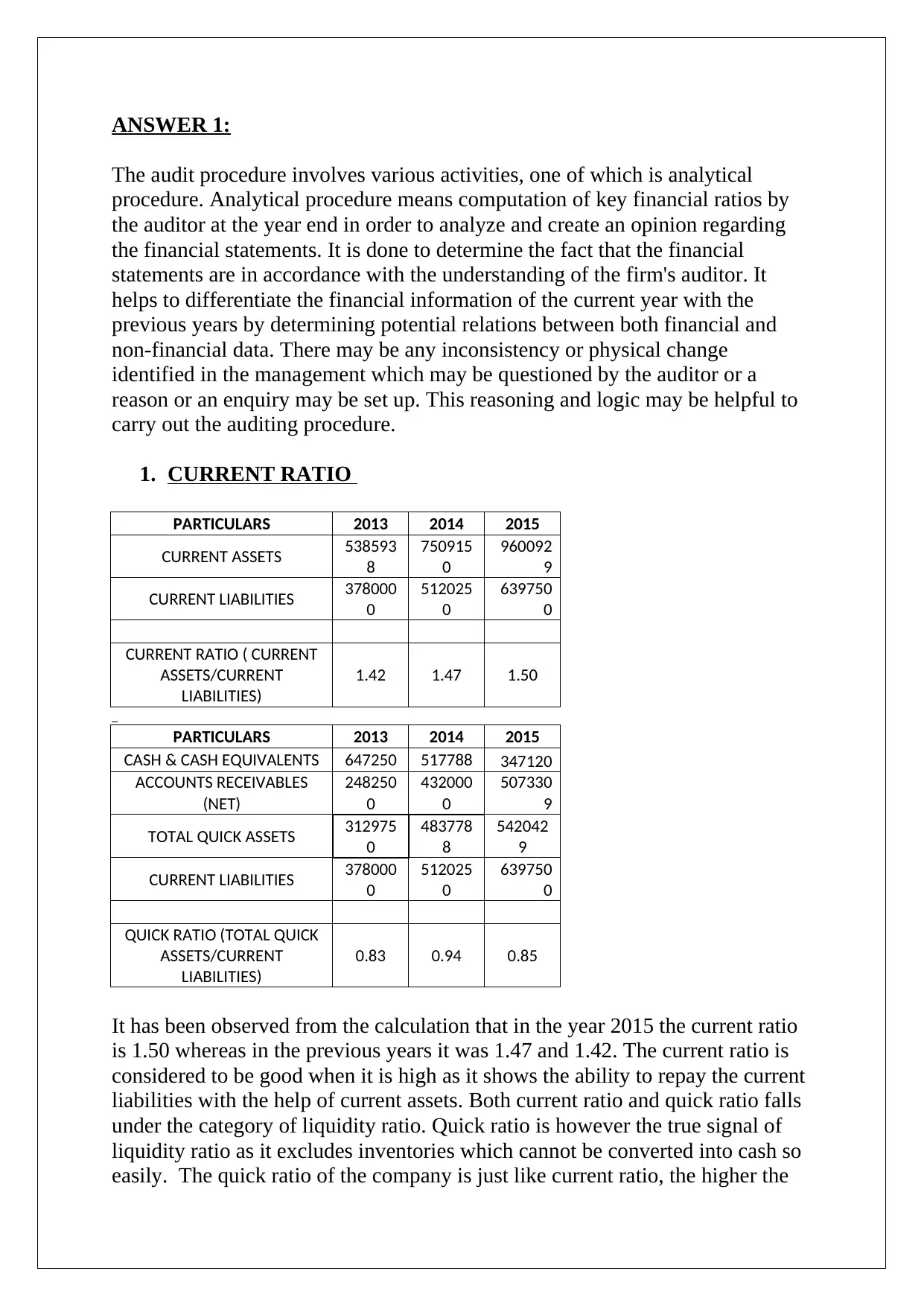
ANSWER 1:
The audit procedure involves various activities, one of which is analytical
procedure. Analytical procedure means computation of key financial ratios by
the auditor at the year end in order to analyze and create an opinion regarding
the financial statements. It is done to determine the fact that the financial
statements are in accordance with the understanding of the firm's auditor. It
helps to differentiate the financial information of the current year with the
previous years by determining potential relations between both financial and
non-financial data. There may be any inconsistency or physical change
identified in the management which may be questioned by the auditor or a
reason or an enquiry may be set up. This reasoning and logic may be helpful to
carry out the auditing procedure.
1. CURRENT RATIO
PARTICULARS 2013 2014 2015
CURRENT ASSETS 538593
8
750915
0
960092
9
CURRENT LIABILITIES 378000
0
512025
0
639750
0
CURRENT RATIO ( CURRENT
ASSETS/CURRENT
LIABILITIES)
1.42 1.47 1.50
PARTICULARS 2013 2014 2015
CASH & CASH EQUIVALENTS 647250 517788 347120
ACCOUNTS RECEIVABLES
(NET)
248250
0
432000
0
507330
9
TOTAL QUICK ASSETS 312975
0
483778
8
542042
9
CURRENT LIABILITIES 378000
0
512025
0
639750
0
QUICK RATIO (TOTAL QUICK
ASSETS/CURRENT
LIABILITIES)
0.83 0.94 0.85
It has been observed from the calculation that in the year 2015 the current ratio
is 1.50 whereas in the previous years it was 1.47 and 1.42. The current ratio is
considered to be good when it is high as it shows the ability to repay the current
liabilities with the help of current assets. Both current ratio and quick ratio falls
under the category of liquidity ratio. Quick ratio is however the true signal of
liquidity ratio as it excludes inventories which cannot be converted into cash so
easily. The quick ratio of the company is just like current ratio, the higher the
The audit procedure involves various activities, one of which is analytical
procedure. Analytical procedure means computation of key financial ratios by
the auditor at the year end in order to analyze and create an opinion regarding
the financial statements. It is done to determine the fact that the financial
statements are in accordance with the understanding of the firm's auditor. It
helps to differentiate the financial information of the current year with the
previous years by determining potential relations between both financial and
non-financial data. There may be any inconsistency or physical change
identified in the management which may be questioned by the auditor or a
reason or an enquiry may be set up. This reasoning and logic may be helpful to
carry out the auditing procedure.
1. CURRENT RATIO
PARTICULARS 2013 2014 2015
CURRENT ASSETS 538593
8
750915
0
960092
9
CURRENT LIABILITIES 378000
0
512025
0
639750
0
CURRENT RATIO ( CURRENT
ASSETS/CURRENT
LIABILITIES)
1.42 1.47 1.50
PARTICULARS 2013 2014 2015
CASH & CASH EQUIVALENTS 647250 517788 347120
ACCOUNTS RECEIVABLES
(NET)
248250
0
432000
0
507330
9
TOTAL QUICK ASSETS 312975
0
483778
8
542042
9
CURRENT LIABILITIES 378000
0
512025
0
639750
0
QUICK RATIO (TOTAL QUICK
ASSETS/CURRENT
LIABILITIES)
0.83 0.94 0.85
It has been observed from the calculation that in the year 2015 the current ratio
is 1.50 whereas in the previous years it was 1.47 and 1.42. The current ratio is
considered to be good when it is high as it shows the ability to repay the current
liabilities with the help of current assets. Both current ratio and quick ratio falls
under the category of liquidity ratio. Quick ratio is however the true signal of
liquidity ratio as it excludes inventories which cannot be converted into cash so
easily. The quick ratio of the company is just like current ratio, the higher the
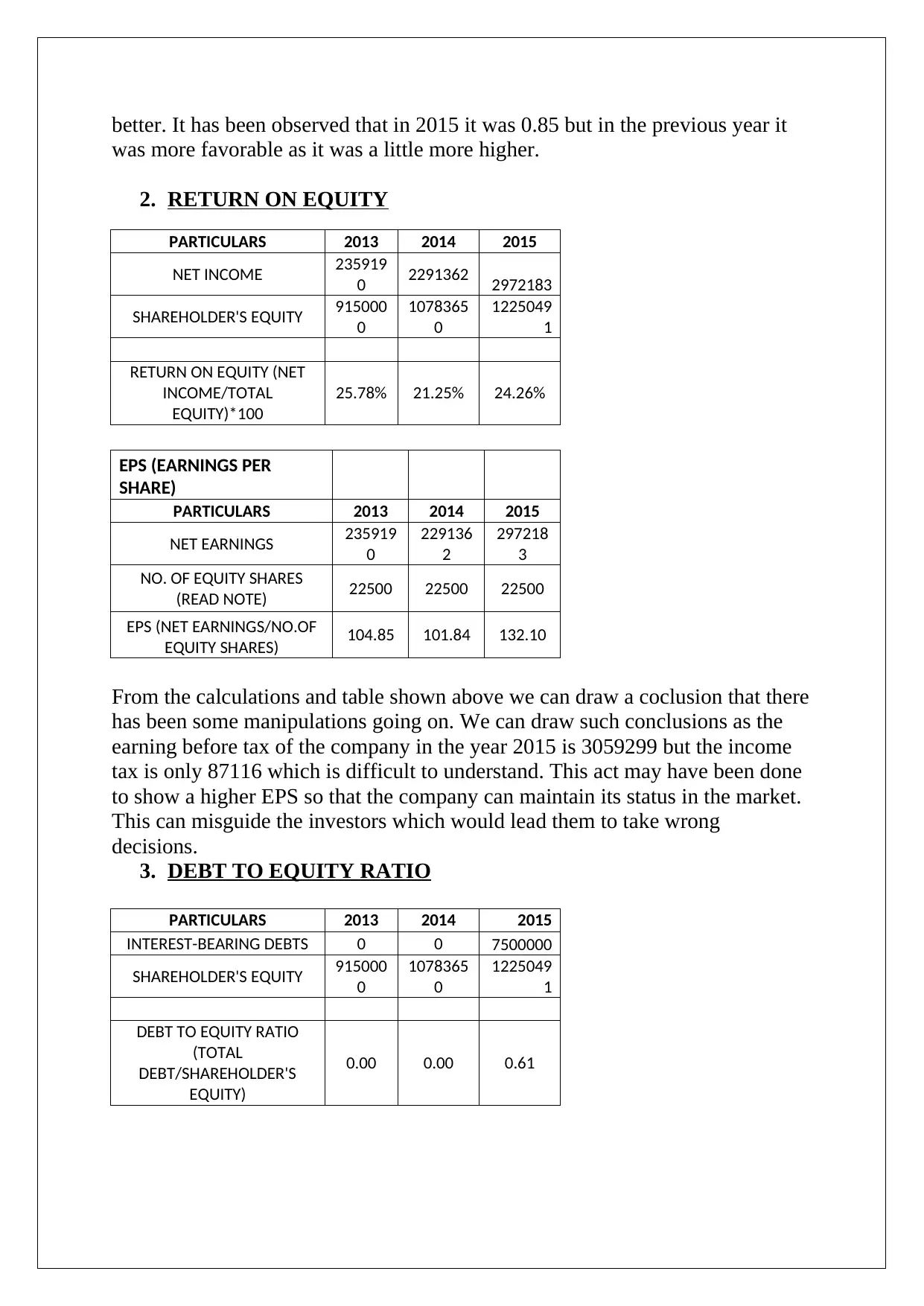
better. It has been observed that in 2015 it was 0.85 but in the previous year it
was more favorable as it was a little more higher.
2. RETURN ON EQUITY
PARTICULARS 2013 2014 2015
NET INCOME 235919
0 2291362 2972183
SHAREHOLDER'S EQUITY 915000
0
1078365
0
1225049
1
RETURN ON EQUITY (NET
INCOME/TOTAL
EQUITY)*100
25.78% 21.25% 24.26%
EPS (EARNINGS PER
SHARE)
PARTICULARS 2013 2014 2015
NET EARNINGS 235919
0
229136
2
297218
3
NO. OF EQUITY SHARES
(READ NOTE) 22500 22500 22500
EPS (NET EARNINGS/NO.OF
EQUITY SHARES) 104.85 101.84 132.10
From the calculations and table shown above we can draw a coclusion that there
has been some manipulations going on. We can draw such conclusions as the
earning before tax of the company in the year 2015 is 3059299 but the income
tax is only 87116 which is difficult to understand. This act may have been done
to show a higher EPS so that the company can maintain its status in the market.
This can misguide the investors which would lead them to take wrong
decisions.
3. DEBT TO EQUITY RATIO
PARTICULARS 2013 2014 2015
INTEREST-BEARING DEBTS 0 0 7500000
SHAREHOLDER'S EQUITY 915000
0
1078365
0
1225049
1
DEBT TO EQUITY RATIO
(TOTAL
DEBT/SHAREHOLDER'S
EQUITY)
0.00 0.00 0.61
was more favorable as it was a little more higher.
2. RETURN ON EQUITY
PARTICULARS 2013 2014 2015
NET INCOME 235919
0 2291362 2972183
SHAREHOLDER'S EQUITY 915000
0
1078365
0
1225049
1
RETURN ON EQUITY (NET
INCOME/TOTAL
EQUITY)*100
25.78% 21.25% 24.26%
EPS (EARNINGS PER
SHARE)
PARTICULARS 2013 2014 2015
NET EARNINGS 235919
0
229136
2
297218
3
NO. OF EQUITY SHARES
(READ NOTE) 22500 22500 22500
EPS (NET EARNINGS/NO.OF
EQUITY SHARES) 104.85 101.84 132.10
From the calculations and table shown above we can draw a coclusion that there
has been some manipulations going on. We can draw such conclusions as the
earning before tax of the company in the year 2015 is 3059299 but the income
tax is only 87116 which is difficult to understand. This act may have been done
to show a higher EPS so that the company can maintain its status in the market.
This can misguide the investors which would lead them to take wrong
decisions.
3. DEBT TO EQUITY RATIO
PARTICULARS 2013 2014 2015
INTEREST-BEARING DEBTS 0 0 7500000
SHAREHOLDER'S EQUITY 915000
0
1078365
0
1225049
1
DEBT TO EQUITY RATIO
(TOTAL
DEBT/SHAREHOLDER'S
EQUITY)
0.00 0.00 0.61
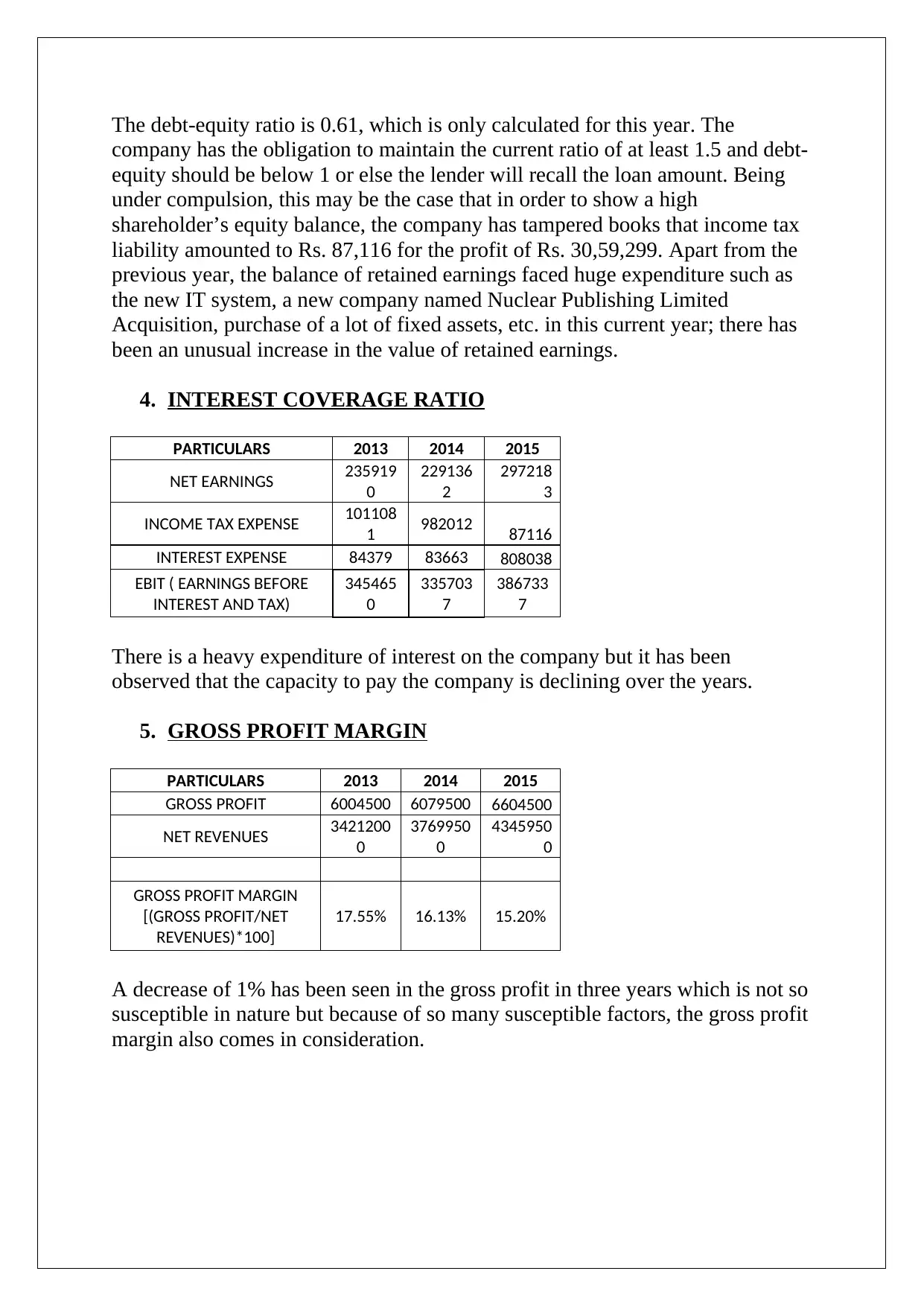
The debt-equity ratio is 0.61, which is only calculated for this year. The
company has the obligation to maintain the current ratio of at least 1.5 and debt-
equity should be below 1 or else the lender will recall the loan amount. Being
under compulsion, this may be the case that in order to show a high
shareholder’s equity balance, the company has tampered books that income tax
liability amounted to Rs. 87,116 for the profit of Rs. 30,59,299. Apart from the
previous year, the balance of retained earnings faced huge expenditure such as
the new IT system, a new company named Nuclear Publishing Limited
Acquisition, purchase of a lot of fixed assets, etc. in this current year; there has
been an unusual increase in the value of retained earnings.
4. INTEREST COVERAGE RATIO
PARTICULARS 2013 2014 2015
NET EARNINGS 235919
0
229136
2
297218
3
INCOME TAX EXPENSE 101108
1 982012 87116
INTEREST EXPENSE 84379 83663 808038
EBIT ( EARNINGS BEFORE
INTEREST AND TAX)
345465
0
335703
7
386733
7
There is a heavy expenditure of interest on the company but it has been
observed that the capacity to pay the company is declining over the years.
5. GROSS PROFIT MARGIN
PARTICULARS 2013 2014 2015
GROSS PROFIT 6004500 6079500 6604500
NET REVENUES 3421200
0
3769950
0
4345950
0
GROSS PROFIT MARGIN
[(GROSS PROFIT/NET
REVENUES)*100]
17.55% 16.13% 15.20%
A decrease of 1% has been seen in the gross profit in three years which is not so
susceptible in nature but because of so many susceptible factors, the gross profit
margin also comes in consideration.
company has the obligation to maintain the current ratio of at least 1.5 and debt-
equity should be below 1 or else the lender will recall the loan amount. Being
under compulsion, this may be the case that in order to show a high
shareholder’s equity balance, the company has tampered books that income tax
liability amounted to Rs. 87,116 for the profit of Rs. 30,59,299. Apart from the
previous year, the balance of retained earnings faced huge expenditure such as
the new IT system, a new company named Nuclear Publishing Limited
Acquisition, purchase of a lot of fixed assets, etc. in this current year; there has
been an unusual increase in the value of retained earnings.
4. INTEREST COVERAGE RATIO
PARTICULARS 2013 2014 2015
NET EARNINGS 235919
0
229136
2
297218
3
INCOME TAX EXPENSE 101108
1 982012 87116
INTEREST EXPENSE 84379 83663 808038
EBIT ( EARNINGS BEFORE
INTEREST AND TAX)
345465
0
335703
7
386733
7
There is a heavy expenditure of interest on the company but it has been
observed that the capacity to pay the company is declining over the years.
5. GROSS PROFIT MARGIN
PARTICULARS 2013 2014 2015
GROSS PROFIT 6004500 6079500 6604500
NET REVENUES 3421200
0
3769950
0
4345950
0
GROSS PROFIT MARGIN
[(GROSS PROFIT/NET
REVENUES)*100]
17.55% 16.13% 15.20%
A decrease of 1% has been seen in the gross profit in three years which is not so
susceptible in nature but because of so many susceptible factors, the gross profit
margin also comes in consideration.
Secure Best Marks with AI Grader
Need help grading? Try our AI Grader for instant feedback on your assignments.
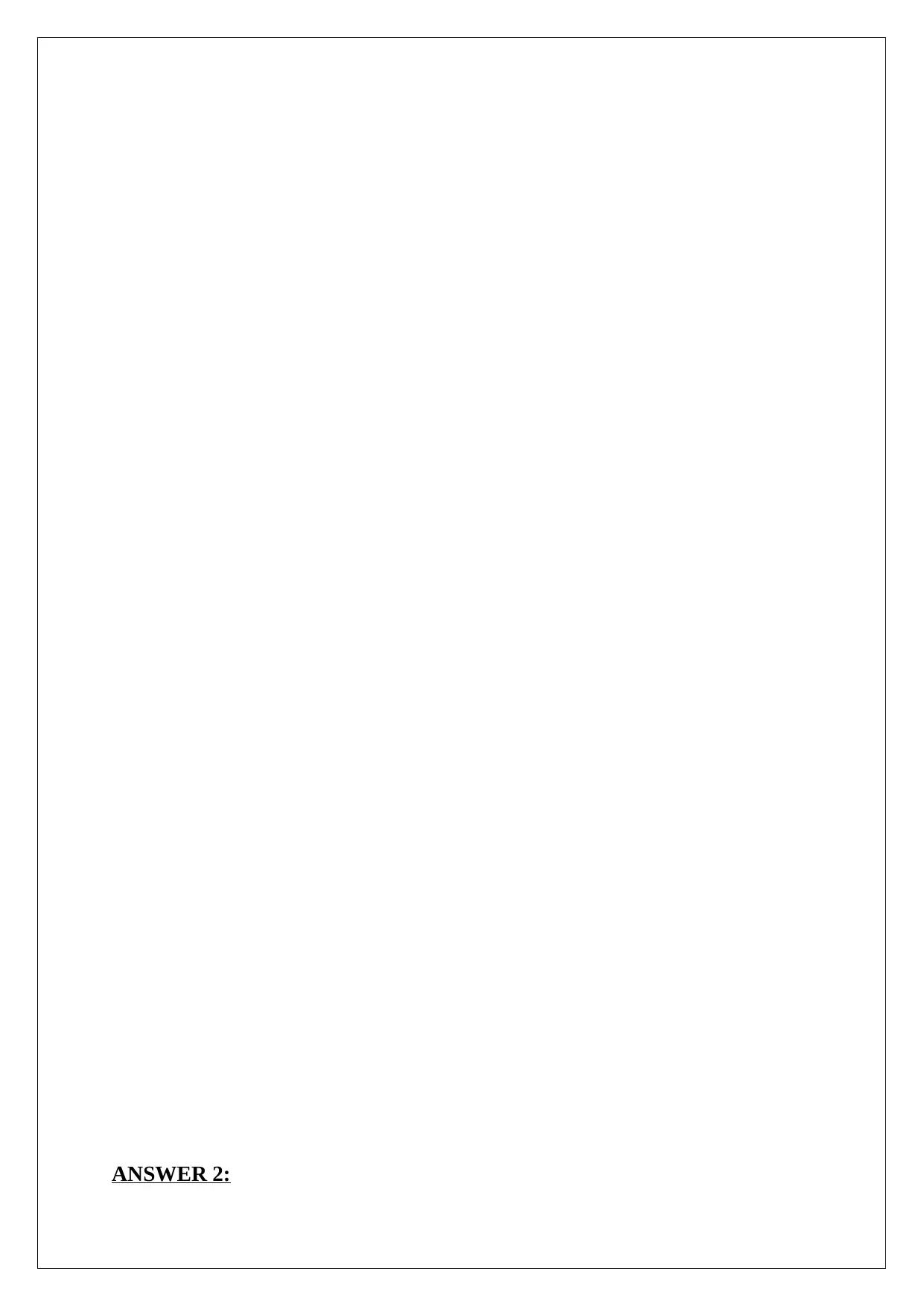
ANSWER 2:
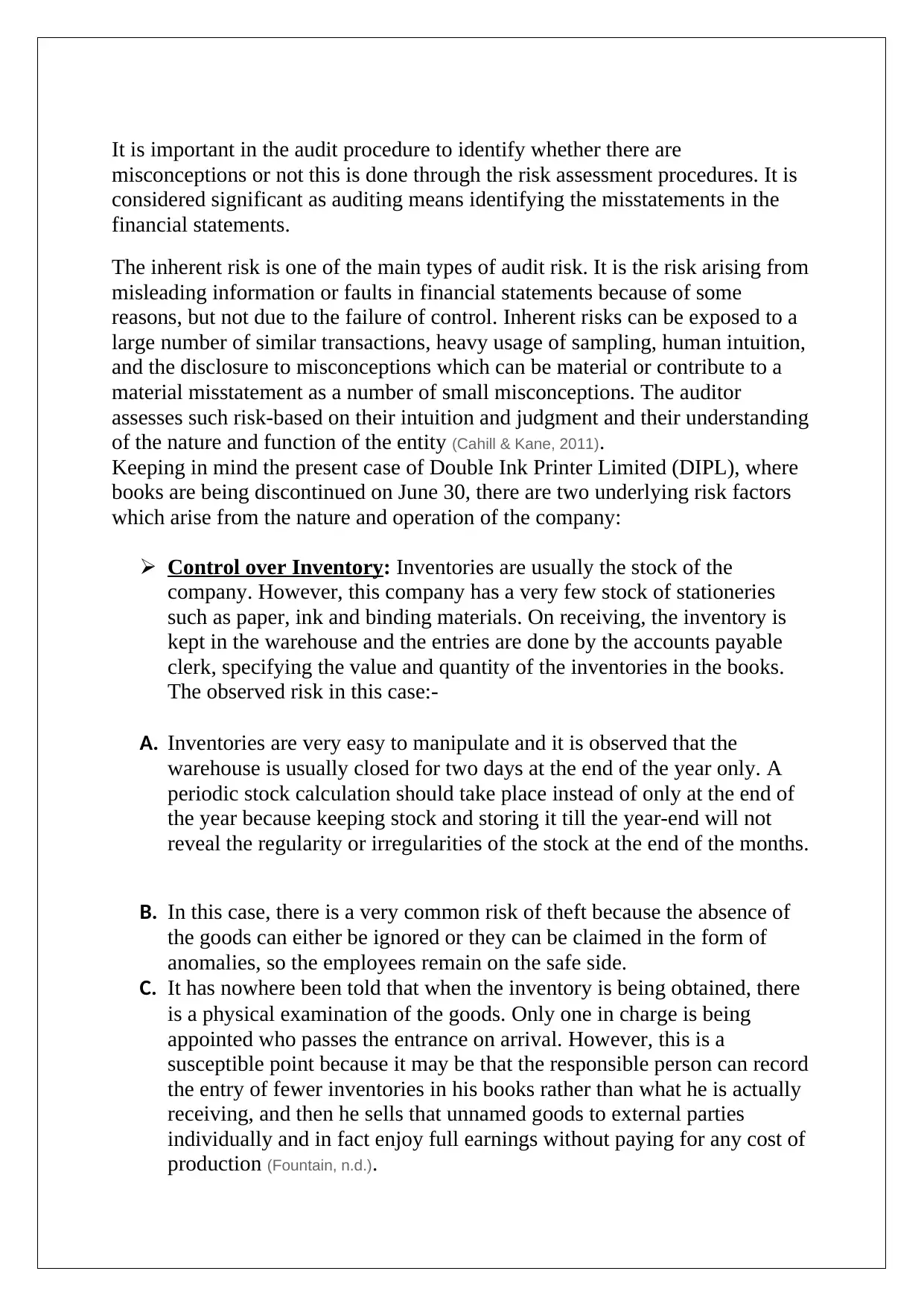
It is important in the audit procedure to identify whether there are
misconceptions or not this is done through the risk assessment procedures. It is
considered significant as auditing means identifying the misstatements in the
financial statements.
The inherent risk is one of the main types of audit risk. It is the risk arising from
misleading information or faults in financial statements because of some
reasons, but not due to the failure of control. Inherent risks can be exposed to a
large number of similar transactions, heavy usage of sampling, human intuition,
and the disclosure to misconceptions which can be material or contribute to a
material misstatement as a number of small misconceptions. The auditor
assesses such risk-based on their intuition and judgment and their understanding
of the nature and function of the entity (Cahill & Kane, 2011).
Keeping in mind the present case of Double Ink Printer Limited (DIPL), where
books are being discontinued on June 30, there are two underlying risk factors
which arise from the nature and operation of the company:
Control over Inventory: Inventories are usually the stock of the
company. However, this company has a very few stock of stationeries
such as paper, ink and binding materials. On receiving, the inventory is
kept in the warehouse and the entries are done by the accounts payable
clerk, specifying the value and quantity of the inventories in the books.
The observed risk in this case:-
A. Inventories are very easy to manipulate and it is observed that the
warehouse is usually closed for two days at the end of the year only. A
periodic stock calculation should take place instead of only at the end of
the year because keeping stock and storing it till the year-end will not
reveal the regularity or irregularities of the stock at the end of the months.
B. In this case, there is a very common risk of theft because the absence of
the goods can either be ignored or they can be claimed in the form of
anomalies, so the employees remain on the safe side.
C. It has nowhere been told that when the inventory is being obtained, there
is a physical examination of the goods. Only one in charge is being
appointed who passes the entrance on arrival. However, this is a
susceptible point because it may be that the responsible person can record
the entry of fewer inventories in his books rather than what he is actually
receiving, and then he sells that unnamed goods to external parties
individually and in fact enjoy full earnings without paying for any cost of
production (Fountain, n.d.).
misconceptions or not this is done through the risk assessment procedures. It is
considered significant as auditing means identifying the misstatements in the
financial statements.
The inherent risk is one of the main types of audit risk. It is the risk arising from
misleading information or faults in financial statements because of some
reasons, but not due to the failure of control. Inherent risks can be exposed to a
large number of similar transactions, heavy usage of sampling, human intuition,
and the disclosure to misconceptions which can be material or contribute to a
material misstatement as a number of small misconceptions. The auditor
assesses such risk-based on their intuition and judgment and their understanding
of the nature and function of the entity (Cahill & Kane, 2011).
Keeping in mind the present case of Double Ink Printer Limited (DIPL), where
books are being discontinued on June 30, there are two underlying risk factors
which arise from the nature and operation of the company:
Control over Inventory: Inventories are usually the stock of the
company. However, this company has a very few stock of stationeries
such as paper, ink and binding materials. On receiving, the inventory is
kept in the warehouse and the entries are done by the accounts payable
clerk, specifying the value and quantity of the inventories in the books.
The observed risk in this case:-
A. Inventories are very easy to manipulate and it is observed that the
warehouse is usually closed for two days at the end of the year only. A
periodic stock calculation should take place instead of only at the end of
the year because keeping stock and storing it till the year-end will not
reveal the regularity or irregularities of the stock at the end of the months.
B. In this case, there is a very common risk of theft because the absence of
the goods can either be ignored or they can be claimed in the form of
anomalies, so the employees remain on the safe side.
C. It has nowhere been told that when the inventory is being obtained, there
is a physical examination of the goods. Only one in charge is being
appointed who passes the entrance on arrival. However, this is a
susceptible point because it may be that the responsible person can record
the entry of fewer inventories in his books rather than what he is actually
receiving, and then he sells that unnamed goods to external parties
individually and in fact enjoy full earnings without paying for any cost of
production (Fountain, n.d.).
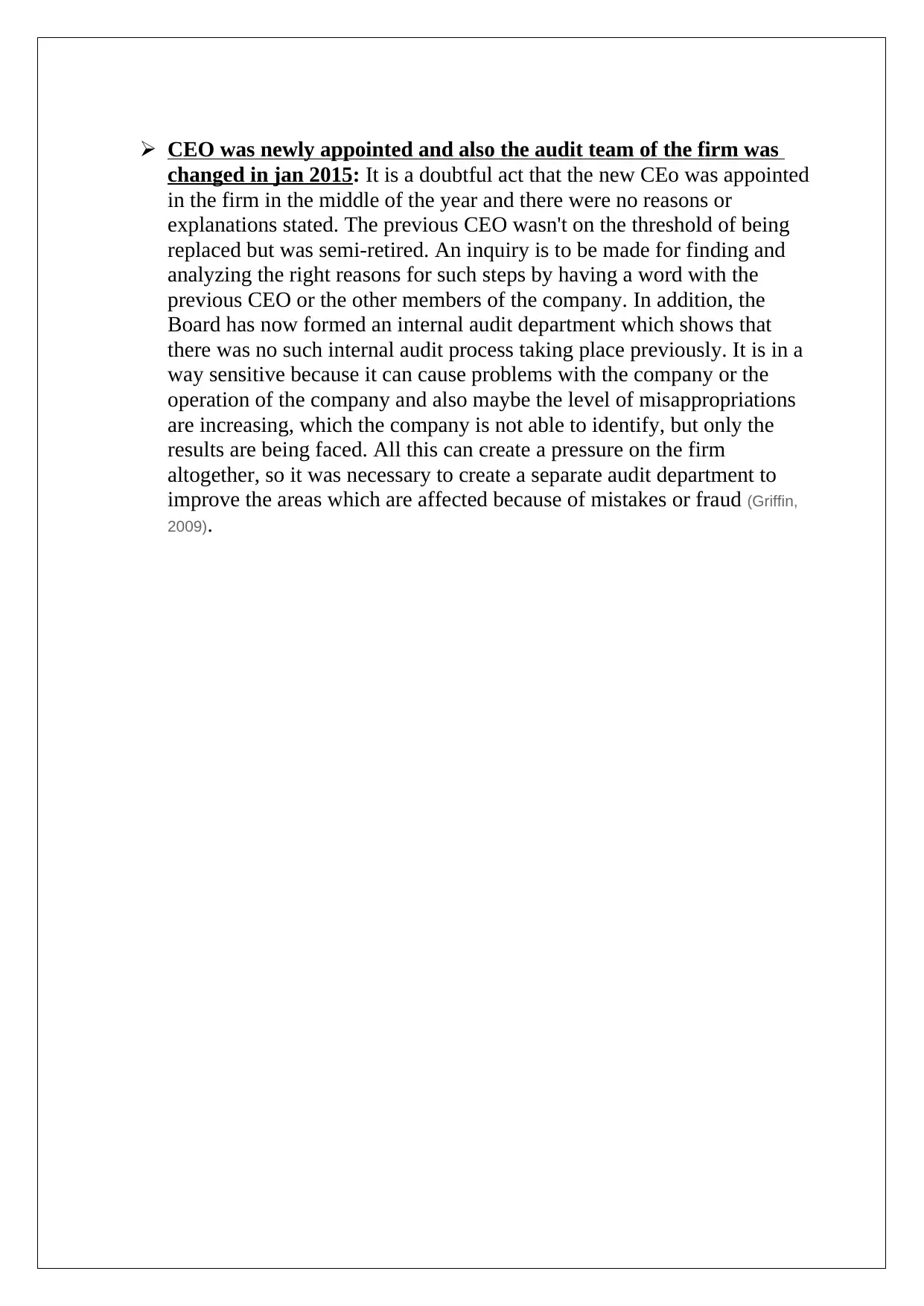
CEO was newly appointed and also the audit team of the firm was
changed in jan 2015: It is a doubtful act that the new CEo was appointed
in the firm in the middle of the year and there were no reasons or
explanations stated. The previous CEO wasn't on the threshold of being
replaced but was semi-retired. An inquiry is to be made for finding and
analyzing the right reasons for such steps by having a word with the
previous CEO or the other members of the company. In addition, the
Board has now formed an internal audit department which shows that
there was no such internal audit process taking place previously. It is in a
way sensitive because it can cause problems with the company or the
operation of the company and also maybe the level of misappropriations
are increasing, which the company is not able to identify, but only the
results are being faced. All this can create a pressure on the firm
altogether, so it was necessary to create a separate audit department to
improve the areas which are affected because of mistakes or fraud (Griffin,
2009).
changed in jan 2015: It is a doubtful act that the new CEo was appointed
in the firm in the middle of the year and there were no reasons or
explanations stated. The previous CEO wasn't on the threshold of being
replaced but was semi-retired. An inquiry is to be made for finding and
analyzing the right reasons for such steps by having a word with the
previous CEO or the other members of the company. In addition, the
Board has now formed an internal audit department which shows that
there was no such internal audit process taking place previously. It is in a
way sensitive because it can cause problems with the company or the
operation of the company and also maybe the level of misappropriations
are increasing, which the company is not able to identify, but only the
results are being faced. All this can create a pressure on the firm
altogether, so it was necessary to create a separate audit department to
improve the areas which are affected because of mistakes or fraud (Griffin,
2009).
Paraphrase This Document
Need a fresh take? Get an instant paraphrase of this document with our AI Paraphraser
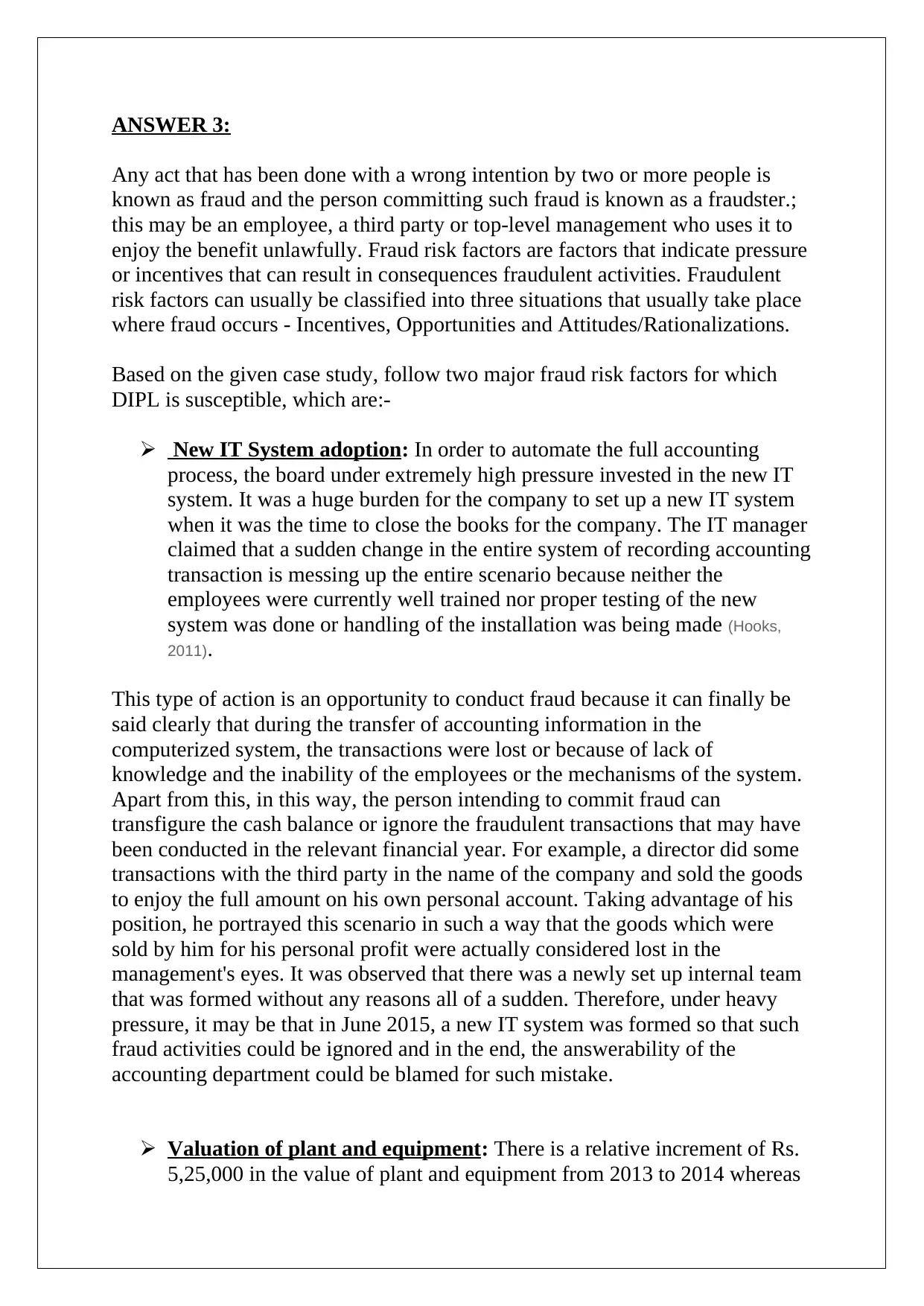
ANSWER 3:
Any act that has been done with a wrong intention by two or more people is
known as fraud and the person committing such fraud is known as a fraudster.;
this may be an employee, a third party or top-level management who uses it to
enjoy the benefit unlawfully. Fraud risk factors are factors that indicate pressure
or incentives that can result in consequences fraudulent activities. Fraudulent
risk factors can usually be classified into three situations that usually take place
where fraud occurs - Incentives, Opportunities and Attitudes/Rationalizations.
Based on the given case study, follow two major fraud risk factors for which
DIPL is susceptible, which are:-
New IT System adoption: In order to automate the full accounting
process, the board under extremely high pressure invested in the new IT
system. It was a huge burden for the company to set up a new IT system
when it was the time to close the books for the company. The IT manager
claimed that a sudden change in the entire system of recording accounting
transaction is messing up the entire scenario because neither the
employees were currently well trained nor proper testing of the new
system was done or handling of the installation was being made (Hooks,
2011).
This type of action is an opportunity to conduct fraud because it can finally be
said clearly that during the transfer of accounting information in the
computerized system, the transactions were lost or because of lack of
knowledge and the inability of the employees or the mechanisms of the system.
Apart from this, in this way, the person intending to commit fraud can
transfigure the cash balance or ignore the fraudulent transactions that may have
been conducted in the relevant financial year. For example, a director did some
transactions with the third party in the name of the company and sold the goods
to enjoy the full amount on his own personal account. Taking advantage of his
position, he portrayed this scenario in such a way that the goods which were
sold by him for his personal profit were actually considered lost in the
management's eyes. It was observed that there was a newly set up internal team
that was formed without any reasons all of a sudden. Therefore, under heavy
pressure, it may be that in June 2015, a new IT system was formed so that such
fraud activities could be ignored and in the end, the answerability of the
accounting department could be blamed for such mistake.
Valuation of plant and equipment: There is a relative increment of Rs.
5,25,000 in the value of plant and equipment from 2013 to 2014 whereas
Any act that has been done with a wrong intention by two or more people is
known as fraud and the person committing such fraud is known as a fraudster.;
this may be an employee, a third party or top-level management who uses it to
enjoy the benefit unlawfully. Fraud risk factors are factors that indicate pressure
or incentives that can result in consequences fraudulent activities. Fraudulent
risk factors can usually be classified into three situations that usually take place
where fraud occurs - Incentives, Opportunities and Attitudes/Rationalizations.
Based on the given case study, follow two major fraud risk factors for which
DIPL is susceptible, which are:-
New IT System adoption: In order to automate the full accounting
process, the board under extremely high pressure invested in the new IT
system. It was a huge burden for the company to set up a new IT system
when it was the time to close the books for the company. The IT manager
claimed that a sudden change in the entire system of recording accounting
transaction is messing up the entire scenario because neither the
employees were currently well trained nor proper testing of the new
system was done or handling of the installation was being made (Hooks,
2011).
This type of action is an opportunity to conduct fraud because it can finally be
said clearly that during the transfer of accounting information in the
computerized system, the transactions were lost or because of lack of
knowledge and the inability of the employees or the mechanisms of the system.
Apart from this, in this way, the person intending to commit fraud can
transfigure the cash balance or ignore the fraudulent transactions that may have
been conducted in the relevant financial year. For example, a director did some
transactions with the third party in the name of the company and sold the goods
to enjoy the full amount on his own personal account. Taking advantage of his
position, he portrayed this scenario in such a way that the goods which were
sold by him for his personal profit were actually considered lost in the
management's eyes. It was observed that there was a newly set up internal team
that was formed without any reasons all of a sudden. Therefore, under heavy
pressure, it may be that in June 2015, a new IT system was formed so that such
fraud activities could be ignored and in the end, the answerability of the
accounting department could be blamed for such mistake.
Valuation of plant and equipment: There is a relative increment of Rs.
5,25,000 in the value of plant and equipment from 2013 to 2014 whereas
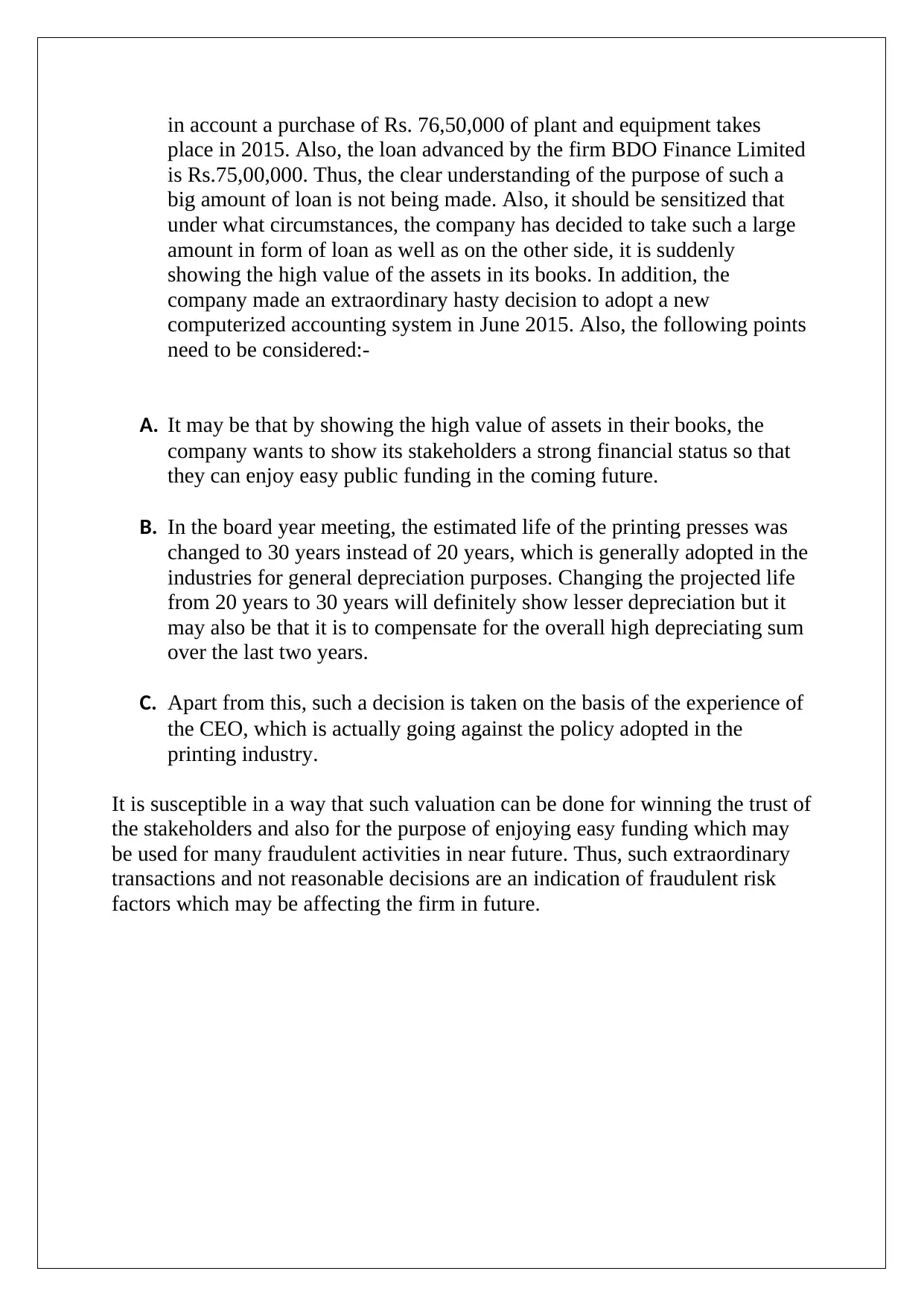
in account a purchase of Rs. 76,50,000 of plant and equipment takes
place in 2015. Also, the loan advanced by the firm BDO Finance Limited
is Rs.75,00,000. Thus, the clear understanding of the purpose of such a
big amount of loan is not being made. Also, it should be sensitized that
under what circumstances, the company has decided to take such a large
amount in form of loan as well as on the other side, it is suddenly
showing the high value of the assets in its books. In addition, the
company made an extraordinary hasty decision to adopt a new
computerized accounting system in June 2015. Also, the following points
need to be considered:-
A. It may be that by showing the high value of assets in their books, the
company wants to show its stakeholders a strong financial status so that
they can enjoy easy public funding in the coming future.
B. In the board year meeting, the estimated life of the printing presses was
changed to 30 years instead of 20 years, which is generally adopted in the
industries for general depreciation purposes. Changing the projected life
from 20 years to 30 years will definitely show lesser depreciation but it
may also be that it is to compensate for the overall high depreciating sum
over the last two years.
C. Apart from this, such a decision is taken on the basis of the experience of
the CEO, which is actually going against the policy adopted in the
printing industry.
It is susceptible in a way that such valuation can be done for winning the trust of
the stakeholders and also for the purpose of enjoying easy funding which may
be used for many fraudulent activities in near future. Thus, such extraordinary
transactions and not reasonable decisions are an indication of fraudulent risk
factors which may be affecting the firm in future.
place in 2015. Also, the loan advanced by the firm BDO Finance Limited
is Rs.75,00,000. Thus, the clear understanding of the purpose of such a
big amount of loan is not being made. Also, it should be sensitized that
under what circumstances, the company has decided to take such a large
amount in form of loan as well as on the other side, it is suddenly
showing the high value of the assets in its books. In addition, the
company made an extraordinary hasty decision to adopt a new
computerized accounting system in June 2015. Also, the following points
need to be considered:-
A. It may be that by showing the high value of assets in their books, the
company wants to show its stakeholders a strong financial status so that
they can enjoy easy public funding in the coming future.
B. In the board year meeting, the estimated life of the printing presses was
changed to 30 years instead of 20 years, which is generally adopted in the
industries for general depreciation purposes. Changing the projected life
from 20 years to 30 years will definitely show lesser depreciation but it
may also be that it is to compensate for the overall high depreciating sum
over the last two years.
C. Apart from this, such a decision is taken on the basis of the experience of
the CEO, which is actually going against the policy adopted in the
printing industry.
It is susceptible in a way that such valuation can be done for winning the trust of
the stakeholders and also for the purpose of enjoying easy funding which may
be used for many fraudulent activities in near future. Thus, such extraordinary
transactions and not reasonable decisions are an indication of fraudulent risk
factors which may be affecting the firm in future.
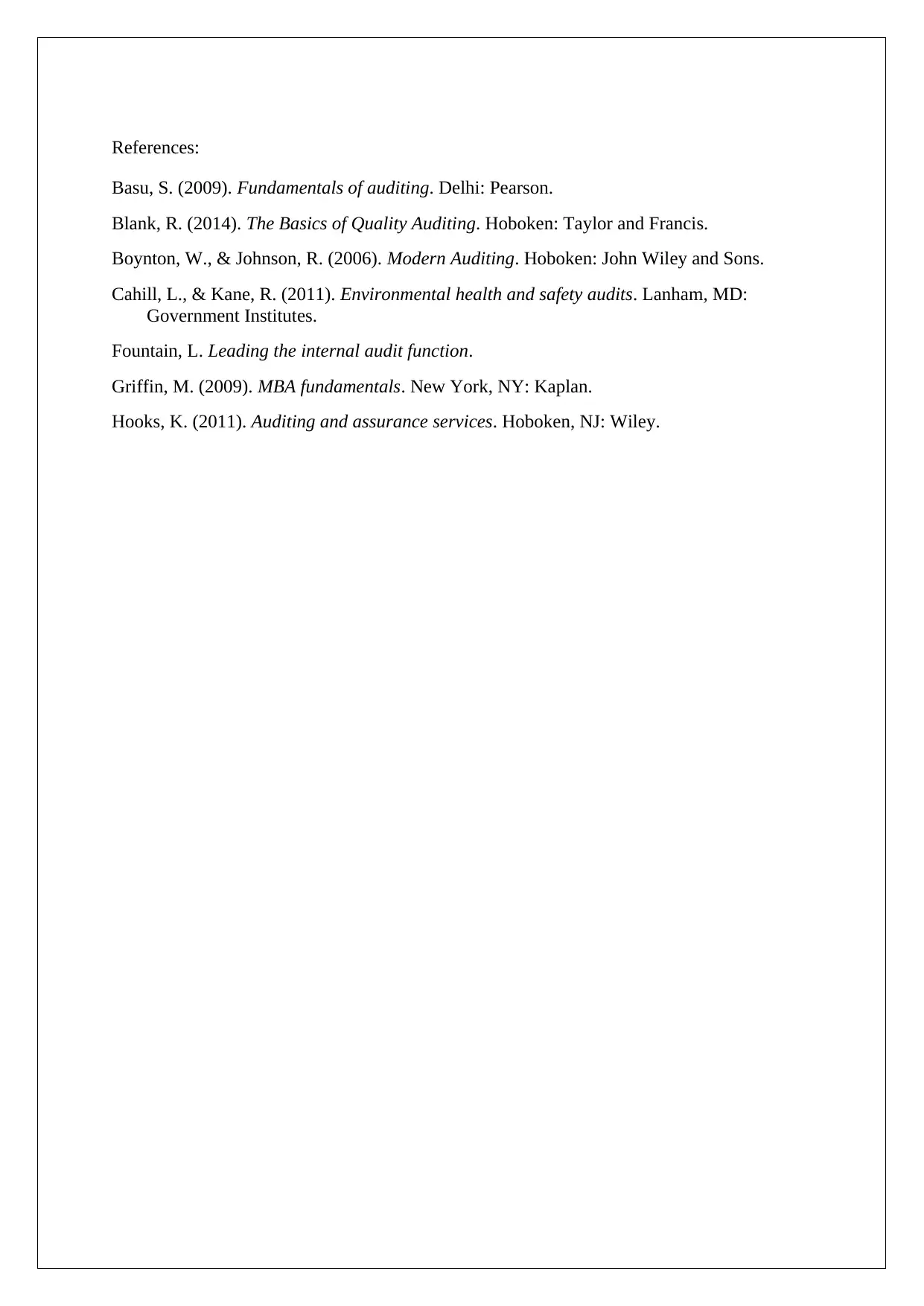
References:
Basu, S. (2009). Fundamentals of auditing. Delhi: Pearson.
Blank, R. (2014). The Basics of Quality Auditing. Hoboken: Taylor and Francis.
Boynton, W., & Johnson, R. (2006). Modern Auditing. Hoboken: John Wiley and Sons.
Cahill, L., & Kane, R. (2011). Environmental health and safety audits. Lanham, MD:
Government Institutes.
Fountain, L. Leading the internal audit function.
Griffin, M. (2009). MBA fundamentals. New York, NY: Kaplan.
Hooks, K. (2011). Auditing and assurance services. Hoboken, NJ: Wiley.
Basu, S. (2009). Fundamentals of auditing. Delhi: Pearson.
Blank, R. (2014). The Basics of Quality Auditing. Hoboken: Taylor and Francis.
Boynton, W., & Johnson, R. (2006). Modern Auditing. Hoboken: John Wiley and Sons.
Cahill, L., & Kane, R. (2011). Environmental health and safety audits. Lanham, MD:
Government Institutes.
Fountain, L. Leading the internal audit function.
Griffin, M. (2009). MBA fundamentals. New York, NY: Kaplan.
Hooks, K. (2011). Auditing and assurance services. Hoboken, NJ: Wiley.
1 out of 10
Related Documents
Your All-in-One AI-Powered Toolkit for Academic Success.
+13062052269
info@desklib.com
Available 24*7 on WhatsApp / Email
![[object Object]](/_next/static/media/star-bottom.7253800d.svg)
Unlock your academic potential
© 2024 | Zucol Services PVT LTD | All rights reserved.





